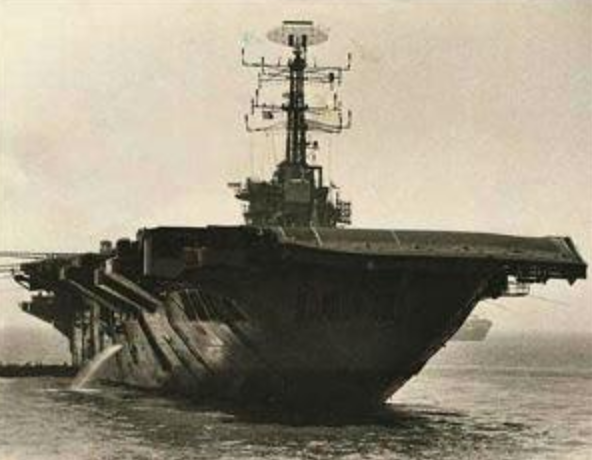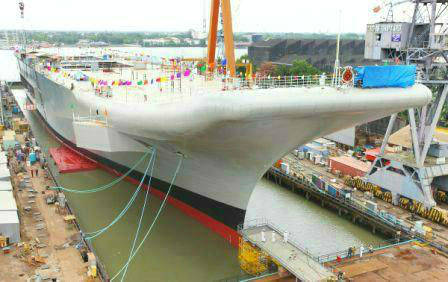Aircraft carriers: India
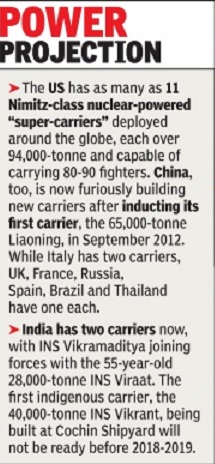
This is a collection of articles archived for the excellence of their content. Readers will be able to edit existing articles and post new articles directly |
Contents |
Sources include
AFP | Aug 12, 2013 [1]
Rajat Pandit , TNN | Aug 12, 2013 The Times of India
Kaveree Bamzai August 10, 2013 | India Today
India's first aircraft carrier INS Vikrant fades into history IANS/ India Today November 21, 2014
INS Vikrant of 1961

From: Sep 3, 2022: The Times of India
See graphic:
INS Vikrant, INS Viraat and INS Vikramaditya, in brief
India's first aircraft carrier INS Vikrant was built for the British Royal Navy as HMS Hercules on Oct 14,1943. It was commissioned in the British Royal Navy in 1945. Built by Vickers Armstrong, the ship's construction was stopped shortly therafter because World War II had ended.
In 1957 the ship was purchased by India in an incomplete condition. The then Indian high commissioner to Britain, Vijayalakshmi Pandit, bought it on behalf of India.
INS Vikrant underwent a four-year-long refitting at the Harland and Wolf Yard in Belfast, Ireland, with an angled flight deck. It was armed with two squadrons of British Seahawks and French Breguet Alize aircraft.
She had a full load displacement of 20,000 tonnes and was commissioned in the Indian Navy on Feb 16, 1959. The sleek, 192-metre-long vessel, a draught of 24 feet, and could sail at a speed of 43 km per hour with a range of 22,000 km.
After she was finally completed she arrived on Nov 3, 1961 to formally join the Indian Navy fleet in the Bombay Harbour, and was received by the then Prime Minister Jawaharlal Nehru and other top officials amidst great fanfare.
In 1961, the landing of the first jet aircraft on board the ship was handled by naval pilot Lt. R.H. Tahiliani.
Indian Navy Captain Pritam Singh was her first commander.
Many years later, Tahiliani not only commanded the same vessel but was also appointed the Chief of Naval Staff in 1984. Admiral Tahiliani retired in 1987.
She was Asia's first aircraft carrier.
Over the years, she was fitted with various types of aircraft, including Westland Sea Kings, HAL Chetak, Sea Harriers and also the dreaded Bofors anti-aircraft guns.
In the 1965 India-Pakistan war, she was claimed as 'sunk' by Pakistan though she was actually undergoing a refit in the dry docks.
The Majestic-class aircraft carrier played a key role in enforcing the naval blockade of East Pakistan during the Indo-Pakistan War of 1971.
For her exciting service full of wartime thrills and action, especially during the 1971 war, INS Vikrant was awarded two Mahavir Chakras and 12 Vir Chakras.
She was decommissioned on Jan 31, 1997.
INS Vikrant was anchored off Mumbai Harbour and served as a museum in Mumbai from 1997 to 2004. The condition of the ship became so bad that it was not worth continuing it as a museum, the authorities felt. Besides, Navy would be able to use the space vacated by the ship in the Dockyard for some other fruitful purposes.
In January 2014, during the hearing of a public interest litigation which opposed the plan to scrap the ship, the Union ministry of defence told the Bombay high court that it had completed its operational life. the Maharashtra government stated that to preserve it as a museum would not be viable financially.
Maintenance and upkeep costs became overwhelming and after many sentimental public protests and legal battles, in April 2014 she was finally sold as scrap for Rs.60 crore to IB Commercials Pvt. Ltd.
"A team of around 200 people has been deployed to dismantle and break down the ship after we completed all legal and technical formalities and secured all requisite clearances from the agencies concerned," IB Commercials Pvt. Ltd. director Abdul Karim Jaka told IANS from the Darukhana ship-breaking yard No.10 at Powder Bunder in southeast Mumbai.
The process, which started in Nov 2014 when the first blow was hammered on her front portion, is expected to be completed within seven-eight months.
INS Viraat: 1987
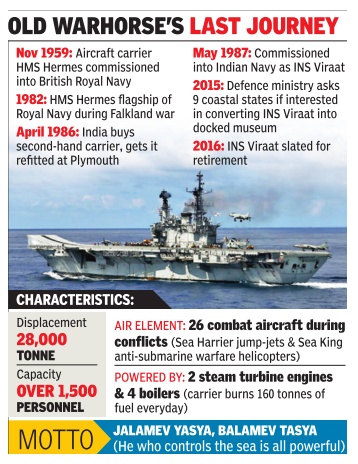
India has one aircraft carrier in operation - a c.1960, 28,000-tonne, British vessel acquired by India in 1987 and renamed INS Viraat - but it will be phased out in the coming years.
INS Viraat, the Indian Navy's present flagship, is among the world's oldest ships in service. Joined the British Royal Navy in 1953 (and the Indian Navy in 1987).The ship will retire by 2017.
2016: World's Oldest Carrier Retires
The second aircraft carrier of the country spent 29 years under the Indian flag and 27 years with the Royal Navy (United Kingdom).The ship holds the Guinness Record for being the oldest serving warship. INS Viraat is a Centaur-Class Aircraft Carrier and served in the Royal Navy as HMS Hermes, which was the flag ship of Royal Navy during the Falk Lands Campaign of 1982. She is commonly referred to as the `Grand Old Lady' among Indian Naval Officers,.
INS Viraat was commissioned into the Indian Navy on May 12, 1987. The ship operated Sea Harrier (White Tigers-fighter aircraft), Seaking 42B (Harpoons-anti submarine helicopters) and Seaking 42C (Commando carrier helicopters) and Chetak (Angles-SAR helicopter) as her main air elements.
The Times of India, Jan 21 2016
Rajat Pandit
INS Viraat sets off on last tour of duty
High Operational Costs Force Retirement Of World's Oldest Running Aircraft Carrier
India's oldest warhorse may now be creaking at all her numerous joints but she is still game for a show of strength, a wee bit of power projection on the high seas for the last time. The 56year-old aircraft carrier INS Viraat has now set sail for what will be her last operational deployment. The 28,000-tonne INS Viraat, which embarked six Sea Harrier jump-jets as well as six Sea King and four Chetak helicopters from Goa on Wednesday, is headed for Visakhapatnam to take part in the International Fleet Review (IFR) from February 5 to 8.
“This will be INS Viraat's last journey , a cross-coast deployment signalling the end of her yeoman service for India before she is retired later this year. On her way back to Mumbai, she will call on all major Indian ports as a final salute,“ said a senior officer on Wednesday .
Originally commissioned in the British Royal Navy as HMS Hermes in November 1959, the 13-storey high carrier was inducted into the Indi an Navy as INS Viraat on May 12, 1987. “Mother“, as she is still affectionately called, packed quite a punch in her days of glory. She represented two acres of sovereign In dian territory cruising on the high seas, ready to unleash her fighters and other weapons against enemies in a jiffy .
With age and high maintenance costs, the world's oldest operational aircraft carrier has lost most of its teeth.But the Navy has managed to cannibalise together six Sea Harrier jump-jets, which are always a sight to watch since they land vertically on the warship deck after taking off from its angled ski-jump.
Commanded by Captain Puneet Chadha, INS Viraat will be joined by the country's other carrier, the 44,570-tonne INS Vikramaditya with her integral MiG-29K fighters, for the IFR. But INS Vikramaditya, or the refurbished Admiral Gorshkov acquired from Russia in late 2013 after a $2.33 billion refit, will have to soldier alone as the country's solitary carrier after that.
The 40,000-tonne indigenous aircraft carrier or INS Vikrant being built at Cochin Shipyard will be ready for induction only by 2018-2019 at the earliest. India will then achieve its long-standing aim to have two fully-operational “carrier battle or strike groups (CBGs), with their accompanying fighters, patrol aircraft, destroyers, submarines frigates and tankers.
CBGs project raw combat power like nothing else. The US has 11 Nimitz-class nuclear-powered “super-carriers“, each over 94,000-tonne and capable of carrying 80-90 fighters, deployed around the globe.
China, too, is fast building new carriers after inducting the 65,000-tonne Liaoning in September 201, even as it is develops “long legs“ with naval deployments spreading to the Indian Ocean and beyond.
As reported by TOI earlier, the defence ministry has sought a response from all nine maritime states if any one of them has “a workable proposal“ to convert INS Viraat into a docked museum.The Navy is even willing to handover a few old aircraft for display on its deck to make it a first-class museum.
The Navy does not want INS Viraat to go the way of INS Vikrant, the country's first aircraft carrier that was acquired from the UK in 1961 and later decommissioned in 1997.
INS Vikramaditya: 2013
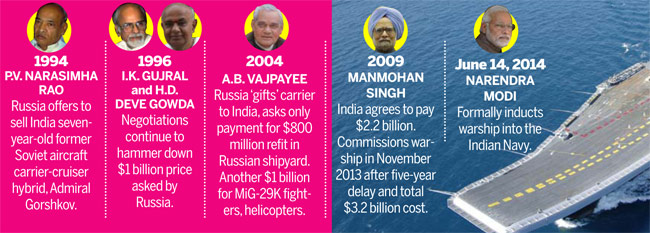
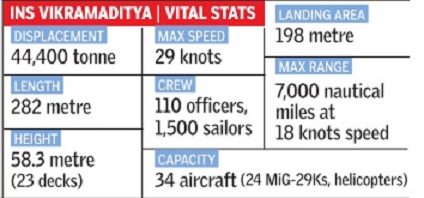
India's ally Russia is set to hand over a third aircraft carrier - INS Vikramaditya – in 2013 after a bitter row over the refurbished Soviet-era warship caused by rising costs and delays.
The Navy is all gung-ho about the induction of the 44,570-tonne INS Vikramaditya, the Admiral Gorshkov carrier has completed sea trials in Russia after a $2.33 billion refit in Russia, by by November 2013.
INS Vishakhapatnam: 2015
Apr 21 2015
Navy's stealth destroyer `Visakhapatnam' launched
Indian Navy's new stealth destroyer, Visakhapatnam, designed indigenously and fitted with advanced features, was launched in Mumbai boosting the maritime force's firepower capability . The Kolkata-class warship, the first of P15-B stealth destroyers, was launched by Minu Dhowan, wife of chief of Naval Staff Admiral R K Dhowan, at Mazagaon Docks Ltd (MDL). Top Navy and MDL officials were present on the occasion. The ship weighed approximately 3,000 tons during the launch.
The 163-metre-long vessel will be propelled by four gas turbines, and is designed to achieve a speed of over 30 knots at a displacement of approximately 7,300 tons. The indigenously designed stealth destroyer will have state-of-the-art weapons, sensors, an advance Action Information System, in Integrated Platform Management system, sophisticated Power Distribution System and a host of other advanced features.
It will be fitted with supersonic surface-to-surface missile system. The system enables the ship to engage shorebased and naval surface targets at long range, making it a lethal platform for strike against enemy targets.
The ship's air defence capability, designed to counter the threat of enemy aircraft and anti-ship cruise missiles, will revolve around the vertical launch and long range surface to air missile system. Four 30mm rapid-fire guns will provide the ship with close-in-defence capability, while an MR gun will enable her to provide effective naval gunfire support.
Indigenously developed twin tube torpedo launchers and rocket launchers will add punch to the ship's antisubmarine capability . The vessel is follow-on of P15A Kolkata-class destroyers with enhanced features.
The vessel is expected to be commissioned in the Navy in 2018. The indigenization content in P15-B class destroyers is a notch above her illustrious predecessors in line with the `Make in India policy' of the Government. The P15-B stealth destroyers have been designed by the force's in-house unit Directorate of Naval Design. The design of Project 15B destroyers is testimony of the Navy's firm commitment towards achieving indigenisation by using high-end technology in the field of weaponssensors machinery and stealth.
INS Vikrant II: built 2013, to be inducted around 2018
India launches first indigenous aircraft carrier INS Vikrant
KOCHI: India launched its first indigenously-built aircraft carrier in Aug 2013, a landmark moment in the $5 billion project that seeks to project the country's power and check the rising influence of China.
The INS Vikrant, which means "courageous" or "bold" in Hindi, is a 40,000-tonne vessel which will carry Russian-built MiG-29 fighter jets and other light aircraft.
While its hull, design and some of its machinery is domestically made, most of its weaponry will be imported as well as its propulsion system, which was sourced from GE in the United States.
Timeline
India is steadily, albeit slowly, building a powerful three-dimensional blue-water Navy for the future at a projected cost upwards of Rs 3 lakh crore between 2013 and 2030.
The 260-metre-long INS Vikrant itself will take till 2020 to become battle-worthy.
The 40,000-tonne carrier will have to undergo extensive weapon and aviation trials, which will include supersonic fighters taking off from its angled ski-jump and landing back on the flight deck with the help of "arrestor" wires, before being declared fully-operational.
When the INS Vikrant comes into full service in 2018 (or 2020 acc , India will become the fifth nation to have designed and built its own aircraft carrier, pushing ahead of China to join an elite club that includes Britain, France, Russia and the United States, which are the only countries that can build carriers of this size. China did induct a carrier, the 65,000-tonne Liaoning, in September 2013, but it was purchased in a half-ready state from Ukraine in 1998.
INS Vikrant will not be ready to go to war anytime before 2020 even if it's handed over to the Navy in 2018, as is now scheduled.
The ship, which will be fitted with weaponry and machinery and then tested over between 2013 and 2014, is a major advance for a country competing for influence in Asia, analysts say.
A power projection platform?
"The need for a strong and vigilant Navy to defend our mainland, island territories, off-shore assets, EEZ and maintaining our sea lanes of communication needs no emphasis," said defence minister A K Antony, at the "launch" ceremony of INS Vikrant at the Cochin Shipyard
"It is going to be deployed in the Indian Ocean region where the world's commercial and economic interests coalesce. India's capability is very much with China in mind," Rahul Bedi, a defence expert with IHS Jane's Defence Weekly, said.
[India needs to safeguard it primary area of geo-political interest stretching from Persian Gulf to Malacca Strait and beyond as well as effectively counter the expanding Chinese Navy's hunt for "strategic space" in the Indian Ocean Region (IOR).]
"All these [advanced naval ships] are power projection platforms, to project India's power as an extension of its diplomacy," Bedi added.
Military hardware: Successes and failures
New Delhi is spending tens of billions of dollars upgrading its mainly Soviet-era military hardware to bolster its defences.
The Indian navy is currently working on 39 ships and has begun planning to make another two aircraft carriers, Bedi said.
The Navy, which is "committed" to supporting "indigenization" as a "strategic core competency", has its plans well chalked-out. "Out of the 47 warships and submarines currently on order, 46 are being built in Indian shipyards," said Navy chief Admiral D K Joshi.
Successes in its long-range missile and naval programmes have been tempered by expensive failures in developing its own aircraft and other land-based weaponry, leaving the country highly dependent on imports.
INS Vikrant is two years behind schedule after problems in sourcing specialised steel from Russia, delays with crucial equipment and even a road accident in which vital diesel generators were damaged.
Vikrant will not alter the balance of power with China
"Its primary role will only be to defend our naval fleet and it will not be used for ground attacks," retired rear admiral K. Raja Menon told AFP.
"It's a defence carrier so it will attack platforms that are coming to attack our (naval) fleet ...without air defence our fleet just cannot survive," Menon said.
C Uday Bhaskar, a retired naval officer and former director of the National Maritime Foundation in New Delhi, said the ship would "enhance India's credibility" - but it "would not alter the balance of power with China".
"China's nuclear expertise and ship-building capabilities are of a higher order," he said.
Overall, India lags far behind China in defence capabilities, analysts say, making the success in beating its regional rival in the race to develop a domestically-produced aircraft carrier significant.
China's first carrier, the Liaoning, which was purchased from the Ukraine, went into service in September 2013. Beijing is reportedly planning to construct or acquire a bigger ship in the future.
Indigenous aircraft carrier
2013 onwards: SAIL manufactures steel for indigenous aircraft carrier
Jayanta Gupta, TNN | Aug 7, 2013,
ROURKELA/BHILAI: Several theories have been forwarded on why the Titanic sank after striking an iceberg in the north Atlantic in 1912. Experts from the Steel Authority of India Ltd (SAIL) now claim that the hull of the ship had too much sulphur and was too brittle to survive the impact. The cold waters of the ocean made matters worse.
The metallurgists had to study the accident as they were asked to perform an extremely difficult task. They had to develop a variety of steel that was hard as well as tough, properties that are in conflict with each other."In 2002, the Navy informed us that India's first indigenous aircraft carrier has been designed. However, no country was ready to export the quality of steel required to build it. We would have to come up with special quality steel for the Indigenous Aircraft Carrier (IAC) or the project would get scrapped. This was an extremely challenging project. We had to achieve properties which were in conflict with each other. We had to achieve low levels of Sulphur in the steel and restrict hydrogen to very low levels. The steel also had to be very hard and extremely tough. Normally, hard steel is not malleable but tough steel is. But then, hard steel is not tough. We had to control 10 elements within a very narrow range for optimum chemical composition," a SAIL metallurgist at Bhilai said.
The Defence Metallurgical Research Laboratory (DMRL) came up with specifications and the Heavy Engineering Corporation (HEC) Ltd in Ranchi succeeded in making ingots but the steel had to cast continuously into plates for the ship. The Cochin Shipyard would require nearly 28,000 tonnes of this steel to build the IAC. "The DMRL called this Project 249. The purpose was to build warship grade steel that was better than the imported variety. The challenge before Bhilai Steel Plant (BSP) was to produce plates of 8-16 mm thickness without Quenching and Tempering (Q&T), through controlled rolling.
The Q&T process - in which the finished plates are reheated and then dunked into oil or water for a specific period and then heated once more to 'iron out' the stresses - is used to strengthen the steel but is not available at BSP. Our challenge was to get the properties in the plates without the Q&T process. The steel we were required to make was called DMR 249 Grade A and would form the hull and other parts of the infrastructure. It took a lot of doing but we came up with a product that was better than any steel that the country had ever imported. It was calculated that the steel could absorb an impact of 78 Joules at 60 degrees Celsius below zero. This was unique. As temperature reduced, the steel became tougher. Later, we succeeded in making the same grade of steel of 18-20 mm thickness without Q&T," another senior official at BSP said.
The steel had special qualities. It could be bended into a 'U' shape without any structural damage. To build the ship, special welding would be required as the steel was unique. At the same time, the Rourkela Steel Plant (RSP) was also busy. The Special Plate Plant (SPP) at RSP had the facilities to carry out the Q&T process and it started working on plates that are thicker than 20 mm. There were two other variants of the steel to be supplied. One was the DMR 249 Grade B manufactured at Alloy Steel Plant in Durgapur. Though small quantities of this would be required, its need was crucial. It was required to build the flight deck of the IAC and had to have spring back qualities. The SPP worked on the plates of DMR 249 Grade B supplied by ASP and strengthened them through Q&T and another round of quenching. The affair was so hush-hush that any portion of scrap left over was sent back to ASP. "We also succeeded in manufacturing the DMR 249 GradeAZ25 that had special quantities. This steel was required for the machine room of the IAC. It had to possess the capability of getting compressed by up to 25per cent. While manufacturing this grade, we succeeded in developing a sample that could be compressed up to 65%," said G S Prasad, chief executive officer.
2021: Trials
Rajat Pandit, August 5, 2021: The Times of India
The much-awaited sea trials of India’s first indigenous aircraft carrier (IAC), which will be reincarnated as INS Vikrant once it is commissioned in August next year, finally kicked off on Wednesday.
Describing the launch of the maiden sea trials of the 40,000-tonne IAC as a “proud and historic day”, the Navy said India has now joined a select group of countries like the US, Russia, China, France and UK to have the “niche capability” to indigenously design, build and integrate a state-ofthe-art aircraft carrier.
The IAC will become fully operational only after the flight trials of MiG-29K supersonic fighter jets, MH-60R multi-role helicopters and indigenously manufactured ALHs (advanced light helicopters) are completed from its deck by around mid-2023.
But once deployed on the high seas, the 262-metre long and 62-meter wide IAC will pack quite an offensive punch as a floating airfield with fighters as well as a wide array of weapons to project raw military power.
Built at the Cochin Shipyard for around Rs 23,000 crore with an indigenous content of 76%, the carrier was first sanctioned by government way back in January 2003. It has been designed for a crew of 1,700, with specialised cabins for women officers, and an operational endurance of around 7,500 nautical miles at a cruising speed of 18 knots. The IAC will be christened INS Vikrant after the country’s first aircraft carrier, which was acquired from the UK in 1961, played a major role during the 1971 war and eventually decommissioned in 1997.
India currently has only one aircraft carrier, the 44,500-tonne INS Vikramaditya, inducted from Russia for $2.33 billion in November 2013. Another $2 billion was spent on procuring 45 MiG-29Ks to operate from its deck.
As reported by TOI earlier, the Navy now wants 36 new multi-role fighters to meet the shortfall in the number of jets required for both INS Vikramaditya and IAC. The case for a third 65,000-tonne carrier (IAC-II), which has been pending since May 2015, is yet to get even the initial “acceptance of necessity” by the government.
China, meanwhile, is assiduously ramping up its naval presence in the Indian Ocean Region. Fast-tracking its aircraft carrier plans, China already has two carriers, Liaoning and Shandong, and is building two more towards its aim of eventually having 10 of them.
The US Navy, of course, has as many as 11 “super” 100,000-tonne carriers, each of which can carry 80-90 fighters. A ‘carrier strike group’ of an aircraft carrier and its accompanying warships is a self-contained and composite war-fighting machine, with inherent flexibility and mobility to shift to a new theatre of operations in 48 to 72 hours.

